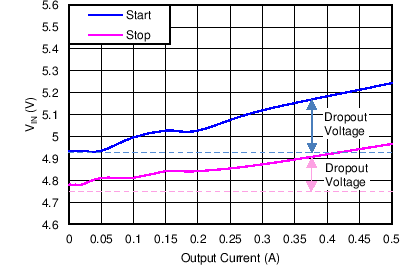-
TPS54560-Q1 4.5-V to 60-V Input, 5-A, Step-Down DC-DC Converter With Eco-Mode™
- 1 Features
- 2 Applications
- 3 Description
- 4 Revision History
- 5 Pin Configuration and Functions
- 6 Specifications
-
7 Detailed Description
- 7.1 Overview
- 7.2 Functional Block Diagram
- 7.3
Feature Description
- 7.3.1 Fixed Frequency PWM Control
- 7.3.2 Slope Compensation Output Current
- 7.3.3 Pulse Skip Eco-Mode
- 7.3.4 Low Dropout Operation and Bootstrap Voltage (BOOT)
- 7.3.5 Error Amplifier
- 7.3.6 Adjusting the Output Voltage
- 7.3.7 Enable and Adjusting Undervoltage Lockout
- 7.3.8 Internal Soft-Start
- 7.3.9 Constant Switching Frequency and Timing Resistor (RT/CLK) Pin)
- 7.3.10 Accurate Current Limit Operation and Maximum Switching Frequency
- 7.3.11 Synchronization to RT/CLK Pin
- 7.3.12 Overvoltage Protection
- 7.3.13 Thermal Shutdown
- 7.3.14 Small Signal Model for Loop Response
- 7.3.15 Simple Small Signal Model for Peak Current Mode Control
- 7.3.16 Small Signal Model for Frequency Compensation
- 7.4 Device Functional Modes
-
8 Applications and Implementation
- 8.1 Application Information
- 8.2
Typical Application
- 8.2.1 Design Requirements
- 8.2.2
Detailed Design Procedure
- 8.2.2.1 Selecting the Switching Frequency
- 8.2.2.2 Output Inductor Selection (LO)
- 8.2.2.3 Output Capacitor
- 8.2.2.4 Catch Diode
- 8.2.2.5 Input Capacitor
- 8.2.2.6 Bootstrap Capacitor Selection
- 8.2.2.7 Undervoltage Lockout Set Point
- 8.2.2.8 Output Voltage and Feedback Resistors Selection
- 8.2.2.9 Compensation
- 8.2.2.10 Discontinuous Conduction Mode and Eco-Mode Boundary
- 8.2.3 Application Curves
- 9 Power Supply Recommendations
- 10Layout
- 11Device and Documentation Support
- 12Mechanical, Packaging, and Orderable Information
- IMPORTANT NOTICE
Package Options
Mechanical Data (Package|Pins)
- DDA|8
Thermal pad, mechanical data (Package|Pins)
- DDA|8
Orderable Information
TPS54560-Q1 4.5-V to 60-V Input, 5-A, Step-Down DC-DC Converter With Eco-Mode™
1 Features
- Qualified for Automotive Applications
- AEC-Q100 Qualified With the Following Results:
- Device Temperature Grade 1: –40°C to 125°C Ambient Operating Temperature Range
- Device HBM ESD Classification Level H1C
- Device CDM ESD Classification Level C3B
- High Efficiency at Light Loads With Pulse-Skipping Eco-Mode™
- 92-mΩ High-Side MOSFET
- 146-μA Operating Quiescent Current and 2-µA Shutdown Current
- 100-kHz to 2.5-MHz Adjustable Switching Frequency
- Synchronizes to External Clock
- Low Dropout at Light Loads with Integrated BOOT Recharge FET
- Adjustable UVLO Voltage and Hysteresis
- 0.8-V 1% Internal Voltage Reference
- 8-Pin HSOIC with PowerPAD™ Package
- –40°C to 150°C TJOperating Range
- Supported by WEBENCH® Software Tool
2 Applications
3 Description
The TPS54560-Q1 is a 60-V, 5-A, step-down regulator with an integrated high side MOSFET. The device survives load dump pulses up to 65 V per ISO 7637. Current mode control provides simple external compensation and flexible component selection. A low-ripple, pulse-skip mode reduces the no load supply current to 146 μA. Shutdown supply current is reduced to 2 μA when the enable pin is pulled low.
Undervoltage lockout is internally set at 4.3 V but can be increased using an external resistor divider at the enable pin. The output voltage start-up ramp is internally controlled to provide a controlled start-up and eliminate overshoot.
A wide adjustable frequency range allows either efficiency or external component size to be optimized. Output current is limited cycle-by-cycle. Frequency foldback and thermal shutdown protects internal and external components during an overload condition.
The TPS54560-Q1 is available in an 8-pin thermally enhanced HSOIC PowerPAD package.
Device Information(1)
| PART NUMBER | PACKAGE | BODY SIZE (NOM) |
|---|---|---|
| TPS54560-Q1 | SO PowerPAD (8) | 3.90 mm x 4.89 mm |
- For all available packages, see the orderable addendum at the end of the datasheet.
Simplified Schematic
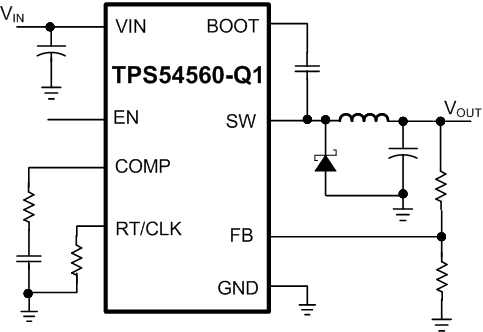
Efficiency vs Load Current
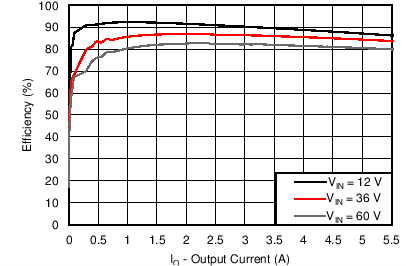
4 Revision History
Changes from * Revision (September 2013) to A Revision
- Added ESD Ratings table, Feature Description section, Device Functional Modes, Application and Implementation section, Power Supply Recommendations section, Layout section, Device and Documentation Support section, and Mechanical, Packaging, and Orderable Information section.Go
5 Pin Configuration and Functions
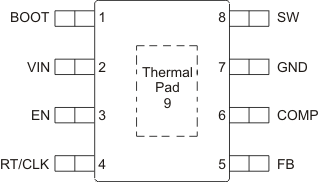
Pin Functions
| PIN | I/O | DESCRIPTION | ||
|---|---|---|---|---|
| NAME | NO. | |||
| BOOT | 1 | O | A bootstrap capacitor is required between BOOT and SW. If the voltage on this capacitor is below the minimum required to operate the high-side MOSFET, the output is switched off until the capacitor is refreshed. | |
| VIN | 2 | I | Input supply voltage with 4.5 V to 60 V operating range. | |
| EN | 3 | I | Enable pin, with internal pull-up current source. Pull below 1.2 V to disable. Float to enable. Adjust the input undervoltage lockout with two resistors. See the Enable and Adjusting Undervoltage Lockout section. | |
| RT/CLK | 4 | I | Resistor Timing and External Clock. An internal amplifier holds this pin at a fixed voltage when using an external resistor to ground to set the switching frequency. If the pin is pulled above the PLL upper threshold, a mode change occurs and the pin becomes a synchronization input. The internal amplifier is disabled and the pin is a high impedance clock input to the internal PLL. If clocking edges stop, the internal amplifier is re-enabled and the operating mode returns to resistor frequency programming. | |
| FB | 5 | I | Inverting input of the transconductance (gm) error amplifier. | |
| COMP | 6 | O | Error amplifier output and input to the output switch current (PWM) comparator. Connect frequency compensation components to this pin. | |
| GND | 7 | – | Ground | |
| SW | 8 | I | The source of the internal high-side power MOSFET and switching node of the converter. | |
| Thermal Pad | 9 | – | GND pin must be electrically connected to the exposed pad on the printed circuit board for proper operation. | |
6 Specifications
6.1 Absolute Maximum Ratings(1)
over operating free-air temperature range (unless otherwise noted)| MIN | MAX | UNIT | ||
|---|---|---|---|---|
| Input voltage | VIN | –0.3 | 65 | V |
| EN | –0.3 | 8.4 | ||
| BOOT | 73 | |||
| FB | –0.3 | 3 | ||
| COMP | –0.3 | 3 | ||
| RT/CLK | –0.3 | 3.6 | ||
| Output voltage | BOOT-SW | 8 | V | |
| SW | –0.6 | 65 | ||
| SW, 10-ns Transient | –2 | 65 | ||
| Operating junction temperature | –40 | 150 | °C | |
| Storage temperature, Tstg | –65 | 150 | °C | |
6.2 ESD Ratings
| VALUE | UNIT | |||
|---|---|---|---|---|
| V(ESD) | Electrostatic discharge | Human-body model (HBM), per AEC Q100-002(1) | ±2000 | V |
| Charged-device model (CDM), per AEC Q100-011 | ±500 | |||
6.3 Recommended Operating Conditions
over operating free-air temperature range (unless otherwise noted)| MIN | MAX | UNIT | ||
|---|---|---|---|---|
| Operating Input Voltage on (VIN pin) | 4.5 | 60 | V | |
| Operating junction temperature, TJ | –40 | 150 | °C | |
6.4 Thermal Information
| THERMAL METRIC(1)(2) | TPS54560-Q1 | UNIT | |
|---|---|---|---|
| DDA | |||
| 8 PINS | |||
| RθJA | Junction-to-ambient thermal resistance | 42.0 | °C/W |
| RθJC(top) | Junction-to-case (top) thermal resistance | 45.8 | |
| RθJB | Junction-to-board thermal resistance | 23.4 | |
| ψJT | Junction-to-top characterization parameter | 5.9 | |
| ψJB | Junction-to-board characterization parameter | 23.4 | |
| RθJC(bot) | Junction-to-case (bottom) thermal resistance | 3.6 | |
- 3 inches x 3 inches, 2 layers, thickness: 0.062 inch
- 2 oz. copper traces located on the top of the PCB
- 2 oz. copper ground plane, bottom layer
- 6 thermal vias (13mil) located under the device package
6.5 Electrical Characteristics
TJ = –40°C to 150°C, VIN = 4.5 to 60V (unless otherwise noted)| PARAMETER | TEST CONDITIONS | MIN | TYP | MAX | UNIT | ||
|---|---|---|---|---|---|---|---|
| SUPPLY VOLTAGE (VIN PIN) | |||||||
| Operating input voltage | 4.5 | 60 | V | ||||
| Internal undervoltage lockout threshold | Rising | 4.1 | 4.3 | 4.48 | V | ||
| Internal undervoltage lockout threshold hysteresis | 325 | mV | |||||
| Shutdown supply current | EN = 0 V, 25°C, 4.5 V ≤ VIN ≤ 60 V | 2.25 | 4.5 | μA | |||
| Operating: nonswitching supply current | FB = 0.9 V, TA = 25°C | 146 | 175 | ||||
| ENABLE AND UVLO (EN PIN) | |||||||
| Enable threshold voltage | No voltage hysteresis, rising and falling | 1.1 | 1.2 | 1.3 | V | ||
| Input current | Enable threshold +50 mV | –4.6 | μA | ||||
| Enable threshold –50 mV | –0.58 | –1.2 | -1.8 | ||||
| Hysteresis current | –2.2 | –3.4 | -4.5 | μA | |||
| Enable to COMP active | VIN = 12 V, TA = 25°C | 540 | µs | ||||
| INTERNAL SOFT-START TIME | |||||||
| Soft-Start Time | fSW = 500 kHz, 10% to 90% | 2.1 | ms | ||||
| Soft-Start Time | fSW = 2.5 MHz, 10% to 90% | 0.42 | ms | ||||
| VOLTAGE REFERENCE | |||||||
| Voltage reference | 0.792 | 0.8 | 0.808 | V | |||
| HIGH-SIDE MOSFET | |||||||
| On-resistance | VIN = 12 V, BOOT-SW = 6 V | 92 | 190 | mΩ | |||
| ERROR AMPLIFIER | |||||||
| Input current | 50 | nA | |||||
| Error amplifier transconductance (gM) | –2 μA < ICOMP < 2 μA, VCOMP = 1 V | 350 | μMhos | ||||
| Error amplifier transconductance (gM) during soft-start | –2 μA < ICOMP < 2 μA, VCOMP = 1 V, VFB = 0.4 V | 77 | μMhos | ||||
| Error amplifier dc gain | VFB = 0.8 V | 10,000 | V/V | ||||
| Min unity gain bandwidth | 2500 | kHz | |||||
| Error amplifier source/sink | V(COMP) = 1 V, 100-mV overdrive | ±30 | μA | ||||
| COMP to SW current transconductance | 17 | A/V | |||||
| CURRENT LIMIT | |||||||
| Current limit threshold | All VIN and temperatures, Open-Loop(1) | 6.3 | 7.5 | 8.8 | A | ||
| All temperatures, VIN = 12 V, Open-Loop(1) | 6.3 | 7.5 | 8.3 | ||||
| VIN = 12 V, TA = 25°C, Open-Loop(1) | 7.1 | 7.5 | 7.9 | ||||
| Current limit threshold delay | 60 | ns | |||||
| THERMAL SHUTDOWN | |||||||
| Thermal shutdown | 176 | °C | |||||
| Thermal shutdown hysteresis | 12 | °C | |||||
| TIMING RESISTOR AND EXTERNAL CLOCK (RT/CLK PIN) | |||||||
| Switching frequency range using RT mode | 100 | 2500 | kHz | ||||
| fSW | Switching frequency | RT = 200 kΩ | 450 | 500 | 550 | kHz | |
| Switching frequency range using CLK mode | 160 | 2300 | kHz | ||||
| Minimum CLK input pulse width | 15 | ns | |||||
| RT/CLK high threshold | 1.55 | 2 | V | ||||
| RT/CLK low threshold | 0.5 | 1.2 | V | ||||
| RT/CLK falling edge to SW rising edge delay | Measured at 500 kHz with RT resistor in series | 55 | ns | ||||
| PLL lock in time | Measured at 500 kHz | 78 | μs | ||||
6.6 Typical Characteristics
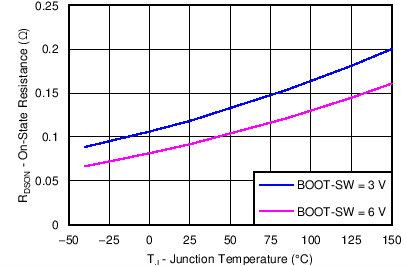
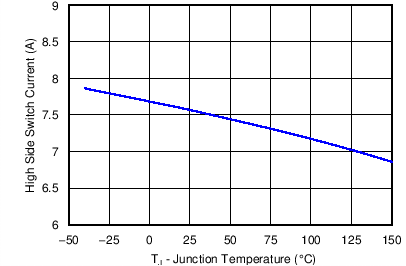
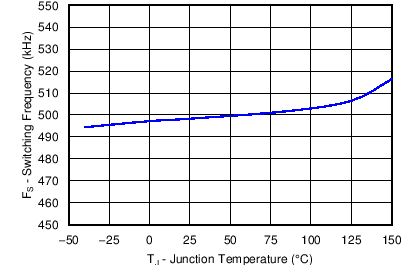
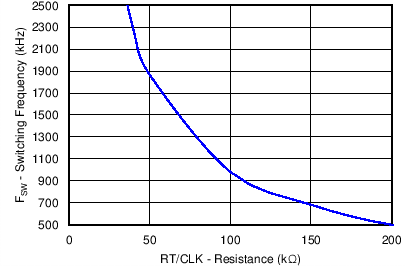
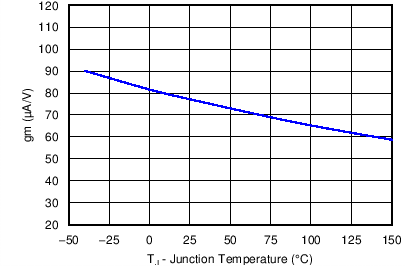
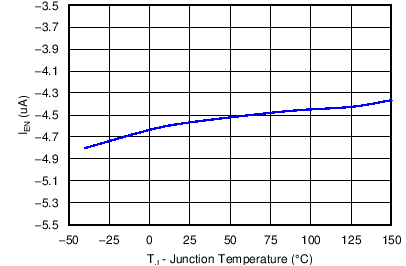

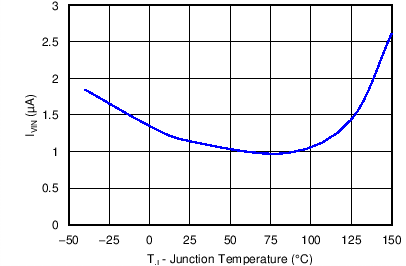
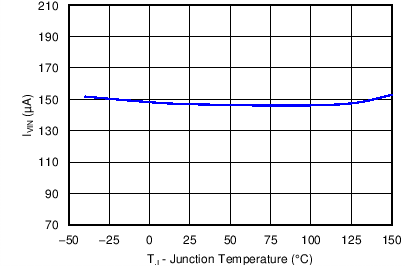
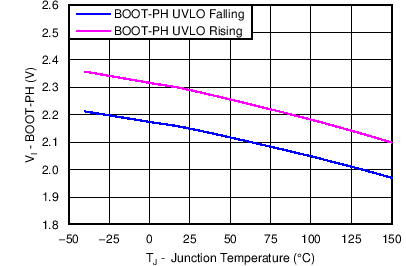
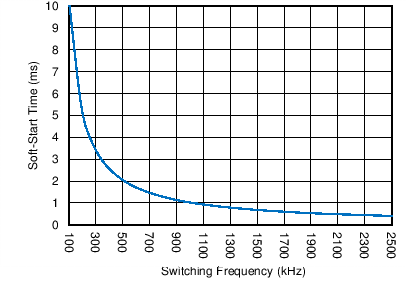
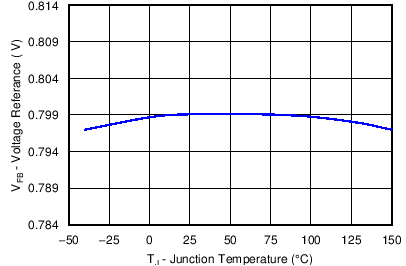
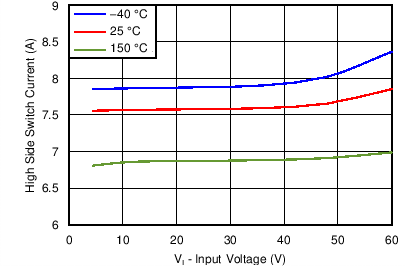
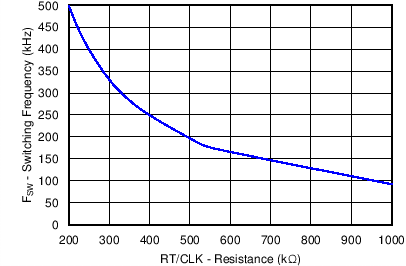
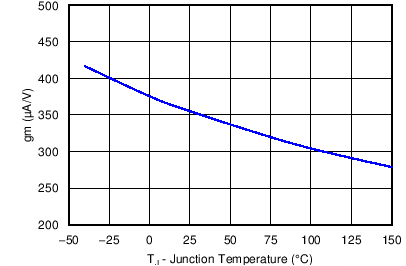
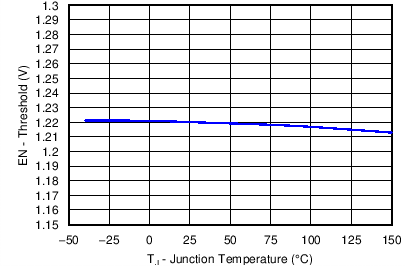
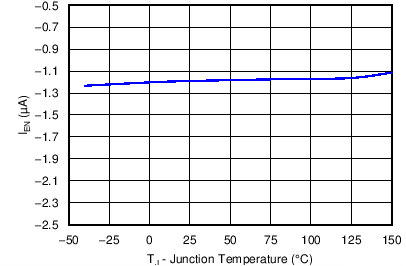
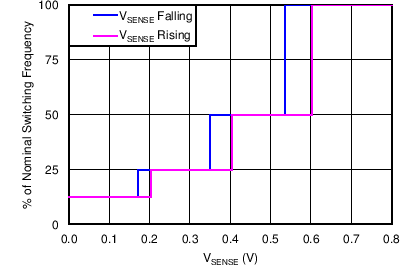
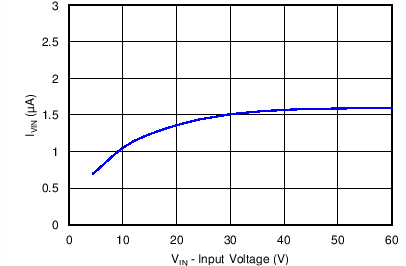
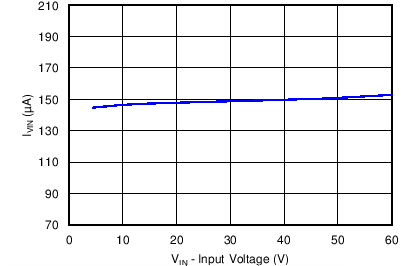

7 Detailed Description
7.1 Overview
The TPS54560-Q1 is a 60-V, 5-A, step-down (buck) regulator with an integrated high-side n-channel MOSFET. The device implements constant frequency, current mode control which reduces output capacitance and simplifies external frequency compensation. The wide switching frequency range of 100 kHz to 2500 kHz allows either efficiency or size optimization when selecting the output filter components. The switching frequency is adjusted using a resistor to ground connected to the RT/CLK pin. The device has an internal phase-locked loop (PLL) connected to the RT/CLK pin that will synchronize the power switch turn on to a falling edge of an external clock signal.
The TPS54560-Q1 has a default input start-up voltage of approximately 4.3 V. The EN pin can be used to adjust the input voltage undervoltage lockout (UVLO) threshold with two external resistors. An internal pull up current source enables operation when the EN pin is floating. The operating current is 146 μA under no load condition (not switching). When the device is disabled, the supply current is 2 μA.
The integrated 92-mΩ, high-side MOSFET supports high efficiency power supply designs capable of delivering 5 amperes of continuous current to a load. The gate drive bias voltage for the integrated high-side MOSFET is supplied by a bootstrap capacitor connected from the BOOT to SW pins. The TPS54560-Q1 reduces the external component count by integrating the bootstrap recharge diode. The BOOT pin capacitor voltage is monitored by a UVLO circuit which turns off the high-side MOSFET when the BOOT to SW voltage falls below a preset threshold. An automatic BOOT capacitor recharge circuit allows the TPS54560-Q1 to operate at high duty cycles approaching 100%. Therefore, the maximum output voltage is near the minimum input supply voltage of the application. The minimum output voltage is the internal 0.8-V feedback reference.
Output overvoltage transients are minimized by an Overvoltage Protection (OVP) comparator. When the OVP comparator is activated, the high-side MOSFET is turned off and remains off until the output voltage is less than 106% of the desired output voltage.
The TPS54560-Q1 includes an internal soft-start circuit that slows the output rise time during start-up to reduce in-rush current and output voltage overshoot. Output overload conditions reset the soft-start timer. When the overload condition is removed, the soft-start circuit controls the recovery from the fault output level to the nominal regulation voltage. A frequency foldback circuit reduces the switching frequency during start-up and overcurrent fault conditions to help maintain control of the inductor current.
7.2 Functional Block Diagram

7.3 Feature Description
7.3.1 Fixed Frequency PWM Control
The TPS54560-Q1 uses fixed frequency, peak current mode control with adjustable switching frequency. The output voltage is compared through external resistors connected to the FB pin to an internal voltage reference by an error amplifier. An internal oscillator initiates the turn on of the high-side power switch. The error amplifier output at the COMP pin controls the high-side power switch current. When the high-side MOSFET switch current reaches the threshold level set by the COMP voltage, the power switch is turned off. The COMP pin voltage will increase and decrease as the output current increases and decreases. The device implements current limiting by clamping the COMP pin voltage to a maximum level. The pulse-skipping Eco-Mode is implemented with a minimum voltage clamp on the COMP pin.
7.3.2 Slope Compensation Output Current
The TPS54560-Q1 adds a compensating ramp to the MOSFET switch current sense signal. This slope compensation prevents sub-harmonic oscillations at duty cycles greater than 50%. The peak current limit of the high-side switch is not affected by the slope compensation and remains constant over the full duty cycle range.
7.3.3 Pulse Skip Eco-Mode
The TPS54560-Q1 operates in a pulse-skipping Eco-Mode at light load currents to improve efficiency by reducing switching and gate drive losses. If the output voltage is within regulation and the peak switch current at the end of any switching cycle is below the pulse-skipping current threshold, the device enters Eco-Mode. The pulse-skipping current threshold is the peak switch current level corresponding to a nominal COMP voltage of 600 mV.
When in Eco-Mode, the COMP pin voltage is clamped at 600 mV and the high-side MOSFET is inhibited. Since the device is not switching, the output voltage begins to decay. The voltage control loop responds to the falling output voltage by increasing the COMP pin voltage. The high-side MOSFET is enabled and switching resumes when the error amplifier lifts COMP above the pulse-skipping threshold. The output voltage recovers to the regulated value, and COMP eventually falls below the Eco-Mode pulse-skipping threshold at which time the device again enters Eco-Mode. The internal PLL remains operational when in Eco-Mode. When operating at light load currents in Eco-Mode, the switching transitions occur synchronously with the external clock signal.
During Eco-Mode operation, the TPS54560-Q1 senses and controls peak switch current, not the average load current. Therefore the load current at which the device enters Eco-Mode is dependent on the output inductor value. The circuit in Figure 36 enters Eco-Mode at about 25.3 mA output current. As the load current approaches zero, the device enters a pulse-skip mode during which it draws only 146 μA input quiescent current.
7.3.4 Low Dropout Operation and Bootstrap Voltage (BOOT)
The TPS54560-Q1 provides an integrated bootstrap voltage regulator. A small capacitor between the BOOT and SW pins provides the gate drive voltage for the high-side MOSFET. The BOOT capacitor is refreshed when the high-side MOSFET is off and the external low-side diode conducts. The recommended value of the BOOT capacitor is 0.1 μF. A ceramic capacitor with an X7R or X5R grade dielectric with a voltage rating of 10 V or higher is recommended for stable performance over temperature and voltage.
When operating with a low voltage difference from input to output, the high-side MOSFET of the TPS54560-Q1 will operate at 100% duty cycle as long as the BOOT to SW pin voltage is greater than 2.1 V. When the voltage from BOOT to SW drops below 2.1 V, the high-side MOSFET is turned off and an integrated low-side MOSFET pulls SW low to recharge the BOOT capacitor. To reduce the losses of the small low-side MOSFET at high output voltages, it is disabled at 24 V output and re-enabled when the output reaches 21.5 V.
Since the gate drive current sourced from the BOOT capacitor is small, the high-side MOSFET can remain on for many switching cycles before the MOSFET is turned off to refresh the capacitor. Thus the effective duty cycle of the switching regulator can be high, approaching 100%. The effective duty cycle of the converter during dropout is mainly influenced by the voltage drops across the power MOSFET, the inductor resistance, the low-side diode voltage and the printed circuit board resistance.
The start and stop voltage for a typical 5-V output application is shown in Figure 22 where the VIN voltage is plotted versus load current. The start voltage is defined as the input voltage needed to regulate the output within 1% of nominal. The stop voltage is defined as the input voltage at which the output drops by 5% or where switching stops.
During high duty cycle (low dropout) conditions, inductor current ripple increases when the BOOT capacitor is being recharged resulting in an increase in output voltage ripple. Increased ripple occurs when the off time required to recharge the BOOT capacitor is longer than the high-side off time associated with cycle-by-cycle PWM control.
At heavy loads, the minimum input voltage must be increased to insure a monotonic startup. Equation 1 can be used to calculate the minimum input voltage for this condition.
_lvsBN0.gif) R
RWhere:
Dmax ≥ 0.9
IB2SW = 100 µA
VF = Forward Drop of the Catch Diode
TSW = 1 / Fsw
VB2SW = VBOOT + VF
VBOOT = (1.41 x VIN - 0.554 - VF / TSW - 1.847 x 103 x IB2SW) / (1.41 + 1 / Tsw)
RDS(on) = 1 / (-0.3 x VB2SW2 + 3.577 x VB2SW - 4.246)
7.3.5 Error Amplifier
The TPS54560-Q1 voltage regulation loop is controlled by a transconductance error amplifier. The error amplifier compares the FB pin voltage to the lower of the internal soft-start voltage or the internal 0.8-V voltage reference. The transconductance (gm) of the error amplifier is 350 μA/V during normal operation. During soft-start operation, the transconductance is reduced to 78 μA/V and the error amplifier is referenced to the internal soft-start voltage.
The frequency compensation components (capacitor, series resistor and capacitor) are connected between the error amplifier output COMP pin and GND pin.
7.3.6 Adjusting the Output Voltage
The internal voltage reference produces a precise 0.8-V, ±1% voltage reference over the operating temperature and voltage range by scaling the output of a bandgap reference circuit. The output voltage is set by a resistor divider from the output node to the FB pin. It is recommended to use 1% tolerance or better divider resistors. Select the low-side resistor RLS for the desired divider current and use Equation 2 to calculate RHS. To improve efficiency at light loads consider using larger value resistors. However, if the values are too high, the regulator will be more susceptible to noise and voltage errors from the FB input current may become noticeable.

7.3.7 Enable and Adjusting Undervoltage Lockout
The TPS54560-Q1 is enabled when the VIN pin voltage rises above 4.3 V and the EN pin voltage exceeds the enable threshold of 1.2 V. The TPS54560-Q1 is disabled when the VIN pin voltage falls below 4 V or when the EN pin voltage is below 1.2 V. The EN pin has an internal pull-up current source, I1, of 1.2 μA that enables operation of the TPS54560-Q1 when the EN pin floats.
If an application requires a higher undervoltage lockout (UVLO) threshold, use the circuit shown in Figure 23 to adjust the input voltage UVLO with two external resistors. When the EN pin voltage exceeds 1.2 V, an additional 3.4 μA of hysteresis current, IHYS, is sourced out of the EN pin. When the EN pin is pulled below 1.2 V, the 3.4 μA Ihys current is removed. This additional current facilitates adjustable input voltage UVLO hysteresis. Use Equation 3 to calculate RUVLO1 for the desired UVLO hysteresis voltage. Use Equation 4 to calculate RUVLO2 for the desired VIN start voltage.
In applications designed to start at relatively low input voltages (that is, from 4.5 V to 9 V) and withstand high input voltages (that is, from 40 V to 60 V), the EN pin may experience a voltage greater than the absolute maximum voltage of 8.4 V during the high input voltage condition. To avoid exceeding this voltage when using the EN resistors, the EN pin is clamped internally with a 5.8 V zener diode that will sink up to 150 μA.
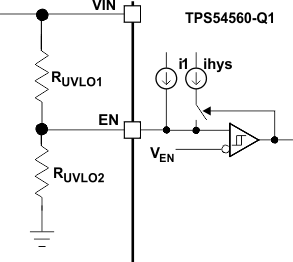 Figure 23. Adjustable Undervoltage Lockout (UVLO)
Figure 23. Adjustable Undervoltage Lockout (UVLO)
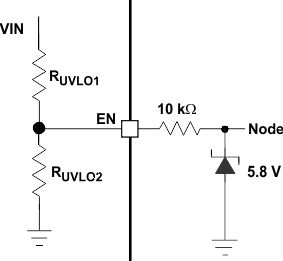 Figure 24. Internal EN Clamp
Figure 24. Internal EN Clamp


7.3.8 Internal Soft-Start
The TPS54560-Q1 has an internal digital soft-start that ramps the reference voltage from zero volts to its final value in 1024 switching cycles. The internal soft-start time (10% to 90%) is calculated using Equation 5

If the EN pin is pulled below the stop threshold of 1.2 V, switching stops and the internal soft-start resets. The soft-start also resets in thermal shutdown.
7.3.9 Constant Switching Frequency and Timing Resistor (RT/CLK) Pin)
The switching frequency of the TPS54560-Q1 is adjustable over a wide range from 100 kHz to 2500 kHz by placing a resistor between the RT/CLK pin and GND pin. The RT/CLK pin voltage is typically 0.5 V and must have a resistor to ground to set the switching frequency. To determine the timing resistance for a given switching frequency, use Equation 6 or Equation 7 or the curves in Figure 5 and Figure 6. To reduce the solution size one would typically set the switching frequency as high as possible, but tradeoffs of the conversion efficiency, maximum input voltage and minimum controllable on time should be considered. The minimum controllable on time is typically 135 ns which limits the maximum operating frequency in applications with high input to output step down ratios. The maximum switching frequency is also limited by the frequency foldback circuit. A more detailed discussion of the maximum switching frequency is provided in the next section.


7.3.10 Accurate Current Limit Operation and Maximum Switching Frequency
The TPS54560-Q1 implements peak current mode control in which the COMP pin voltage controls the peak current of the high-side MOSFET. A signal proportional to the high-side switch current and the COMP pin voltage are compared each cycle. When the peak switch current intersects the COMP control voltage, the high-side switch is turned off. During overcurrent conditions that pull the output voltage low, the error amplifier increases switch current by driving the COMP pin high. The error amplifier output is clamped internally at a level which sets the peak switch current limit. The TPS54560-Q1 provides an accurate current limit threshold with a typical current limit delay of 60 ns. With smaller inductor values, the delay will result in a higher peak inductor current. The relationship between the inductor value and the peak inductor current is shown in Figure 25.
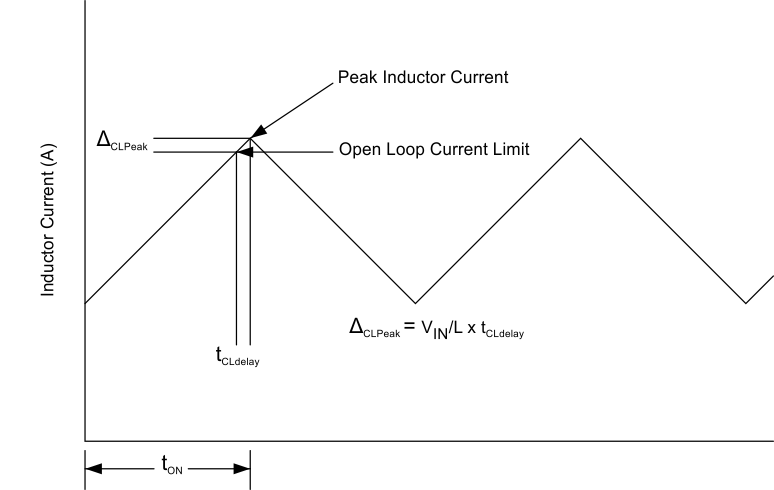 Figure 25. Current Limit Delay
Figure 25. Current Limit Delay
To protect the converter in overload conditions at higher switching frequencies and input voltages, the TPS54560-Q1 implements a frequency foldback. The oscillator frequency is divided by 1, 2, 4, and 8 as the FB pin voltage falls from 0.8 V to 0 V. The TPS54560-Q1 uses a digital frequency foldback to enable synchronization to an external clock during normal start-up and fault conditions. During short-circuit events, the inductor current can exceed the peak current limit because of the high input voltage and the minimum controllable on time. When the output voltage is forced low by the shorted load, the inductor current decreases slowly during the switch off time. The frequency foldback effectively increases the off time by increasing the period of the switching cycle providing more time for the inductor current to ramp down.
With a maximum frequency foldback ratio of 8, there is a maximum frequency at which the inductor current can be controlled by frequency foldback protection. Equation 9 calculates the maximum switching frequency at which the inductor current will remain under control when VOUT is forced to VOUT(SC). The selected operating frequency should not exceed the calculated value.
Equation 8 calculates the maximum switching frequency limitation set by the minimum controllable on time and the input to output step down ratio. Setting the switching frequency above this value will cause the regulator to skip switching pulses to achieve the low duty cycle required at maximum input voltage.


| IO | Output current |
| ICL | Current limit |
| Rdc | inductor resistance |
| VIN | maximum input voltage |
| VOUT | output voltage |
| VOUTSC | output voltage during short |
| Vd | diode voltage drop |
| RDS(on) | switch on resistance |
| tON | controllable on time |
| ƒDIV | frequency divide equals (1, 2, 4, or 8) |
7.3.11 Synchronization to RT/CLK Pin
The RT/CLK pin can receive a frequency synchronization signal from an external system clock. To implement this synchronization feature connect a square wave to the RT/CLK pin through either circuit network shown in Figure 26. The square wave applied to the RT/CLK pin must switch lower than 0.5 V and higher than 1.7 V and have a pulse-width greater than 15 ns. The synchronization frequency range is 160 kHz to 2300 kHz. The rising edge of the SW will be synchronized to the falling edge of RT/CLK pin signal. The external synchronization circuit should be designed such that the default frequency set resistor is connected from the RT/CLK pin to ground when the synchronization signal is off. When using a low impedance signal source, the frequency set resistor is connected in parallel with an ac coupling capacitor to a termination resistor (e.g., 50 Ω) as shown in Figure 26. The two resistors in series provide the default frequency setting resistance when the signal source is turned off. The sum of the resistance should set the switching frequency close to the external CLK frequency. It is recommended to ac couple the synchronization signal through a 10 pF ceramic capacitor to RT/CLK pin.
The first time the RT/CLK is pulled above the PLL threshold the TPS54560-Q1 switches from the RT resistor free-running frequency mode to the PLL synchronized mode. The internal 0.5 V voltage source is removed and the RT/CLK pin becomes high impedance as the PLL starts to lock onto the external signal. The switching frequency can be higher or lower than the frequency set with the RT/CLK resistor. The device transitions from the resistor mode to the PLL mode and locks onto the external clock frequency within 78 microseconds. During the transition from the PLL mode to the resistor programmed mode, the switching frequency will fall to 150 kHz and then increase or decrease to the resistor programmed frequency when the 0.5 V bias voltage is reapplied to the RT/CLK resistor.
The switching frequency is divided by 8, 4, 2, and 1 as the FB pin voltage ramps from 0 to 0.8 volts. The device implements a digital frequency foldback to enable synchronizing to an external clock during normal start-up and fault conditions. Figure 27, Figure 28 and Figure 29 show the device synchronized to an external system clock in continuous conduction mode (CCM), discontinuous conduction (DCM), and pulse skip mode (Eco-Mode).
 Figure 26. Synchronizing to a System Clock
Figure 26. Synchronizing to a System Clock
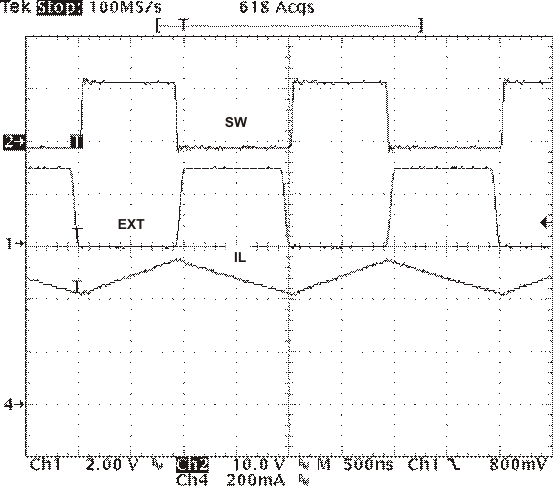 Figure 27. Plot of Synchronizing in CCM
Figure 27. Plot of Synchronizing in CCM
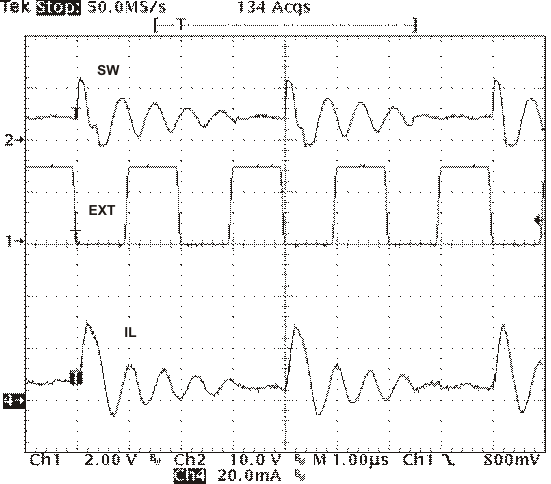 Figure 29. Plot of Synchronizing in Eco-Mode
Figure 29. Plot of Synchronizing in Eco-Mode
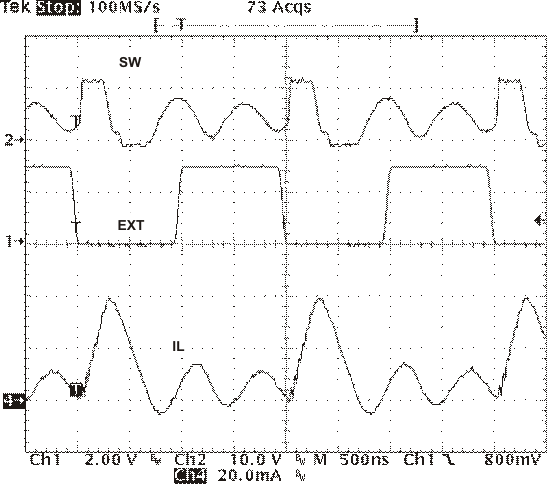 Figure 28. Plot of Synchronizing in DCM
Figure 28. Plot of Synchronizing in DCM
7.3.12 Overvoltage Protection
The TPS54560-Q1 incorporates an output overvoltage protection (OVP) circuit to minimize voltage overshoot when recovering from output fault conditions or strong unload transients in designs with low output capacitance. For example, when the power supply output is overloaded the error amplifier compares the actual output voltage to the internal reference voltage. If the FB pin voltage is lower than the internal reference voltage for a considerable time, the output of the error amplifier will increase to a maximum voltage corresponding to the peak current limit threshold. When the overload condition is removed, the regulator output rises and the error amplifier output transitions to the normal operating level. In some applications, the power supply output voltage can increase faster than the response of the error amplifier output resulting in an output overshoot.
The OVP feature minimizes output overshoot when using a low value output capacitor by comparing the FB pin voltage to the rising OVP threshold which is nominally 109% of the internal voltage reference. If the FB pin voltage is greater than the rising OVP threshold, the high-side MOSFET is immediately disabled to minimize output overshoot. When the FB voltage drops below the falling OVP threshold which is nominally 106% of the internal voltage reference, the high-side MOSFET resumes normal operation.
7.3.13 Thermal Shutdown
The TPS54560-Q1 provides an internal thermal shutdown to protect the device when the junction temperature exceeds 176°C. The high-side MOSFET stops switching when the junction temperature exceeds the thermal trip threshold. Once the die temperature falls below 164°C, the device reinitiates the power-up sequence controlled by the internal soft-start circuitry.
7.3.14 Small Signal Model for Loop Response
Figure 30 shows an equivalent model for the TPS54560-Q1 control loop which can be simulated to check the frequency response and dynamic load response. The error amplifier is a transconductance amplifier with a gmEA of 350 μA/V. The error amplifier can be modeled using an ideal voltage controlled current source. The resistor Ro and capacitor Co model the open-loop gain and frequency response of the amplifier. The 1-mV AC voltage source between the nodes A and B effectively breaks the control loop for the frequency response measurements. Plotting C/A provides the small signal response of the frequency compensation. Plotting A/B provides the small signal response of the overall loop. The dynamic loop response can be evaluated by replacing RL with a current source with the appropriate load step amplitude and step rate in a time domain analysis. This equivalent model is only valid for continuous conduction mode (CCM) operation.
 Figure 30. Small Signal Model for Loop Response
Figure 30. Small Signal Model for Loop Response
7.3.15 Simple Small Signal Model for Peak Current Mode Control
Figure 31 describes a simple small signal model that can be used to design the frequency compensation. The TPS54560-Q1 power stage can be approximated by a voltage-controlled current source (duty cycle modulator) supplying current to the output capacitor and load resistor. The control to output transfer function is shown in Equation 10 and consists of a DC gain, one dominant pole, and one ESR zero. The quotient of the change in switch current and the change in COMP pin voltage (node C in Figure 30) is the power stage transconductance, gmPS. The gmPS for the TPS54560-Q1 is 17 A/V. The low-frequency gain of the power stage is the product of the transconductance and the load resistance as shown in Equation 11.
As the load current increases and decreases, the low-frequency gain decreases and increases, respectively. This variation with the load may seem problematic at first glance, but fortunately the dominant pole moves with the load current (see Equation 12). The combined effect is highlighted by the dashed line in the right half of Figure 31. As the load current decreases, the gain increases and the pole frequency lowers, keeping the 0-dB crossover frequency the same with varying load conditions. The type of output capacitor chosen determines whether the ESR zero has a profound effect on the frequency compensation design. Using high-ESR aluminum electrolytic capacitors may reduce the number frequency compensation components needed to stabilize the overall loop because the phase margin is increased by the ESR zero of the output capacitor (see Equation 13).
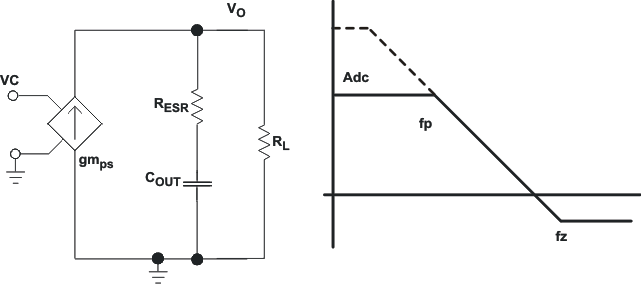 Figure 31. Simple Small Signal Model and Frequency Response for Peak Current Mode Control
Figure 31. Simple Small Signal Model and Frequency Response for Peak Current Mode Control
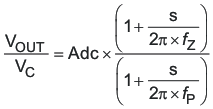



7.3.16 Small Signal Model for Frequency Compensation
The TPS54560-Q1 uses a transconductance amplifier for the error amplifier and supports three of the commonly-used frequency compensation circuits. Compensation circuits Type 2A, Type 2B, and Type 1 are shown in Figure 32. Type 2 circuits are typically implemented in high bandwidth power-supply designs using low-ESR output capacitors. The Type 1 circuit is used with power-supply designs with high-ESR aluminum electrolytic or tantalum capacitors. Equation 14 and Equation 15 relate the frequency response of the amplifier to the small signal model in Figure 32. The open-loop gain and bandwidth are modeled using the RO and CO shown in Figure 32. See the application section for a design example using a Type 2A network with a low ESR output capacitor.
Equation 14 through Equation 23 are provided as a reference. An alternative is to use WEBENCH software tools to create a design based on the power supply requirements.
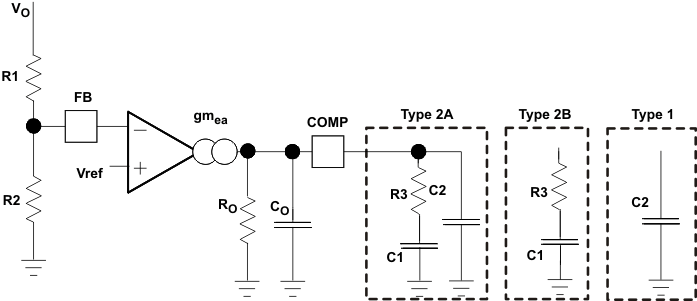 Figure 32. Types of Frequency Compensation
Figure 32. Types of Frequency Compensation
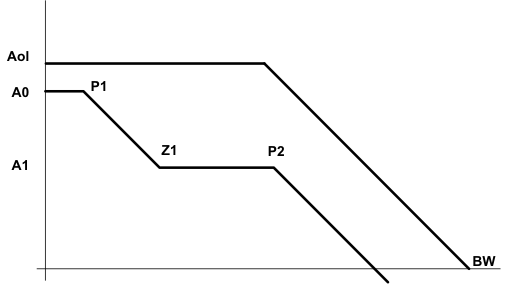 Figure 33. Frequency Response of the Type 2A and Type 2B Frequency Compensation
Figure 33. Frequency Response of the Type 2A and Type 2B Frequency Compensation


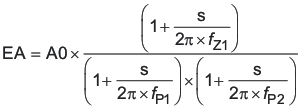







7.4 Device Functional Modes
7.4.1 Operation With VI = 4.5 V (Minimum VDD)
TI recommends operating the TPS54561-Q1 device with input voltages above 4.5 V. The typical V DD UVLO threshold is 4.3 V, and the device may operate at input voltages down to the UVLO voltage. At input voltages below the actual UVLO voltage, the device does not switch. If an external resistor divider pulls the EN pin up to V DD or EN pin is floating, when V DD passes the UVLO threshold the device becomes active. Switching begins, and the soft-start sequence initiates. The TPS54561-Q1 device starts at the soft-start time determined by the external capacitance on the SS/TR pin
7.4.2 Operation With EN Control
The enable threshold voltage is 1.2 V typical. With EN held below that voltage, the device shuts down and switching stops even if V DD is above its UVLO threshold. The IC quiescent current decreases in this state. After increasing the EN pin voltage above the threshold while V DD is above its UVLO threshold, the device becomes active. Switching resumes and the soft-start sequence begins. The TPS54561-Q1 device starts at the soft-start time determined by the external capacitance at the SS/TR pin.
7.4.3 Alternative Power-Supply Topologies
7.4.3.1 Inverting Power Supply
One use of the TPS54561-Q1 is to convert a positive input voltage to a negative output voltage. Ideal applications are amplifiers requiring a negative power supply. For a more-detailed example, see Create an Inverting Power Supply From a Step-Down Regulator, application report SLVA317.
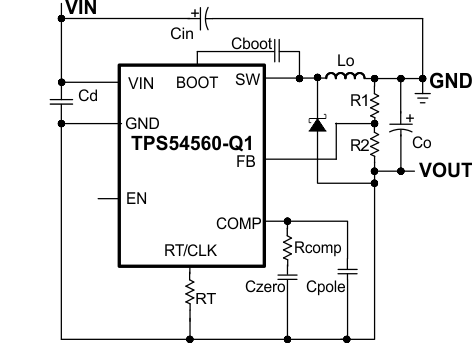 Figure 34. TPS54560-Q1 Inverting Power Supply from SLVA317 Application Note
Figure 34. TPS54560-Q1 Inverting Power Supply from SLVA317 Application Note
7.4.3.2 Split-Rail Power Supply
Another use of the TPS54561-Q1 device is to convert a positive input voltage to a split-rail positive- and negative-output voltage by using a coupled inductor. Ideal applications are amplifiers requiring a split-rail positive- and negative-voltage power supply. For a more-detailed example, see Creating a Split-Rail Power Supply With a Wide Input Voltage Buck Regulator, application report SLVA369.
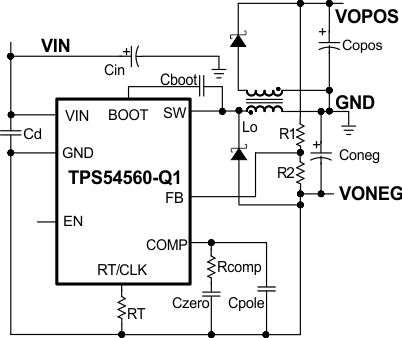 Figure 35. TPS54560-Q1 Split Rail Power Supply based on the SLVA369 Application Note
Figure 35. TPS54560-Q1 Split Rail Power Supply based on the SLVA369 Application Note
8 Applications and Implementation
NOTE
Information in the following applications sections is not part of the TI component specification, and TI does not warrant its accuracy or completeness. TI’s customers are responsible for determining suitability of components for their purposes. Customers should validate and test their design implementation to confirm system functionality.
8.1 Application Information
The TPS54560-Q1 device is a 60-V, 5-A, step-down regulator with an integrated high-side MOSFET. This device typically converts a higher DC voltage to a lower DC voltage with a maximum available output current of 5 A. Example applications are: 12-V, 24-V and 48-V industrial, automotive and communication power systems. The WEBENCH software uses an iterative design procedure and accesses a comprehensive database of components when generating a design.
8.2 Typical Application
 Figure 36. 5 V Output TPS54560-Q1 Design Example
Figure 36. 5 V Output TPS54560-Q1 Design Example
8.2.1 Design Requirements
A few parameters must be known in order to start the design process. These requirements are typically determined at the system level. Calculations can be done with the aid of WEBENCH or the excel spreadsheet (SLVC452) located on the product page. This example is designed to the following known parameters:
| PARAMETER | UNIT |
|---|---|
| Output Voltage | 5 V |
| Transient Response 1.25 A to 3.75 A load step | ΔVOUT = 4 % |
| Maximum Output Current | 5 A |
| Input Voltage | 12 V nom. 7 V to 60 V |
| Output Voltage Ripple | 0.5% of VOUT |
| Start Input Voltage (rising VIN) | 6.5 V |
| Stop Input Voltage (falling VIN) | 5 V |
8.2.2 Detailed Design Procedure
Use the following design procedure to select component values for the TPS54560-Q1 device.
8.2.2.1 Selecting the Switching Frequency
The first step is to choose a switching frequency for the regulator. Typically, the designer uses the highest switching frequency possible since this produces the smallest solution size. High switching frequency allows for lower value inductors and smaller output capacitors compared to a power supply that switches at a lower frequency. The switching frequency that can be selected is limited by the minimum on-time of the internal power switch, the input voltage, the output voltage and the frequency foldback protection.
Equation 8 and Equation 9 should be used to calculate the upper limit of the switching frequency for the regulator. Choose the lower value result from the two equations. Switching frequencies higher than these values results in pulse skipping or the lack of overcurrent protection during a short circuit.
The typical minimum on time, tonmin, is 135 ns for the TPS54560-Q1. For this example, the output voltage is 5 V and the maximum input voltage is 60 V, which allows for a maximum switch frequency up to 708 kHz to avoid pulse skipping from Equation 8. To ensure overcurrent runaway is not a concern during short circuits use Equation 9 to determine the maximum switching frequency for frequency foldback protection. With a maximum input voltage of 60 V, assuming a diode voltage of 0.7 V, inductor resistance of 11 mΩ, switch resistance of 92 mΩ, a current limit value of 6 A and short circuit output voltage of 0.1 V, the maximum switching frequency is 855 kHz.
For this design, a lower switching frequency of 400 kHz is chosen to operate comfortably below the calculated maximums. To determine the timing resistance for a given switching frequency, use Equation 6 or the curve in Figure 6. The switching frequency is set by resistor R3 shown in Figure 36. For 400 kHz operation, the closest standard value resistor is 243 kΩ.



8.2.2.2 Output Inductor Selection (LO)
To calculate the minimum value of the output inductor, use Equation 27.
KIND is a ratio that represents the amount of inductor ripple current relative to the maximum output current. The inductor ripple current is filtered by the output capacitor. Therefore, choosing high inductor ripple currents impacts the selection of the output capacitor since the output capacitor must have a ripple current rating equal to or greater than the inductor ripple current. In general, the inductor ripple value is at the discretion of the designer, however, the following guidelines may be used.
For designs using low ESR output capacitors such as ceramics, a value as high as KIND = 0.3 may be desirable. When using higher ESR output capacitors, KIND = 0.2 yields better results. Since the inductor ripple current is part of the current mode PWM control system, the inductor ripple current should always be greater than 150 mA for stable PWM operation. In a wide input voltage regulator, it is best to choose relatively large inductor ripple current. This provides sufficienct ripple current with the input voltage at the minimum.
For this design example, KIND = 0.3 and the inductor value is calculated to be 7.6 μH. The nearest standard value is 7.2 μH. It is important that the RMS current and saturation current ratings of the inductor not be exceeded. The RMS and peak inductor current can be found from Equation 29 and Equation 30. For this design, the RMS inductor current is 5 A and the peak inductor current is 5.8 A. The chosen inductor is a WE 7447798720, which has a saturation current rating of 7.9 A and an RMS current rating of 6 A.
As the equation set demonstrates, lower ripple currents will reduce the output voltage ripple of the regulator but will require a larger value of inductance. Selecting higher ripple currents will increase the output voltage ripple of the regulator but allow for a lower inductance value.
The current flowing through the inductor is the inductor ripple current plus the output current. During power up, faults or transient load conditions, the inductor current can increase above the peak inductor current level calculated above. In transient conditions, the inductor current can increase up to the switch current limit of the device. For this reason, the most conservative design approach is to choose an inductor with a saturation current rating equal to or greater than the switch current limit of the TPS54560-Q1 which is nominally 7.5 A.




8.2.2.3 Output Capacitor
There are three primary considerations for selecting the value of the output capacitor. The output capacitor determines the modulator pole, the output voltage ripple, and how the regulator responds to a large change in load current. The output capacitance needs to be selected based on the most stringent of these three criteria.
The desired response to a large change in the load current is the first criteria. The output capacitor needs to supply the increased load current until the regulator responds to the load step. The regulator does not respond immediately to a large, fast increase in the load current such as transitioning from no load to a full load. The regulator usually needs two or more clock cycles for the control loop to sense the change in output voltage and adjust the peak switch current in response to the higher load. The output capacitance must be large enough to supply the difference in current for 2 clock cycles to maintain the output voltage within the specified range. Equation 31 shows the minimum output capacitance necessary, where ΔIOUT is the change in output current, ƒsw is the regulators switching frequency and ΔVOUT is the allowable change in the output voltage. For this example, the transient load response is specified as a 4% change in VOUT for a load step from 1.25 A to 3.75 A. Therefore, ΔIOUT is 3.75 A - 1.25 A = 2.5 A and ΔVOUT = 0.04 × 5 = 0.2 V. Using these numbers gives a minimum capacitance of 62.5 μF. This value does not take the ESR of the output capacitor into account in the output voltage change. For ceramic capacitors, the ESR is usually small enough to be ignored. Aluminum electrolytic and tantalum capacitors have higher ESR that must be included in load step calculations.
The output capacitor must also be sized to absorb energy stored in the inductor when transitioning from a high to low load current. The catch diode of the regulator can not sink current so energy stored in the inductor can produce an output voltage overshoot when the load current rapidly decreases. A typical load step response is shown in Figure 37. The excess energy absorbed in the output capacitor will increase the voltage on the capacitor. The capacitor must be sized to maintain the desired output voltage during these transient periods. Equation 32 calculates the minimum capacitance required to keep the output voltage overshoot to a desired value, where LO is the value of the inductor, IOH is the output current under heavy load, IOL is the output under light load, Vf is the peak output voltage, and Vi is the initial voltage. For this example, the worst case load step will be from 3.75 A to 1.25 A. The output voltage increases during this load transition and the stated maximum in our specification is 4 % of the output voltage. This makes Vf = 1.04 × 5 = 5.2. Vi is the initial capacitor voltage which is the nominal output voltage of 5 V. Using these numbers in Equation 32 yields a minimum capacitance of
44.1 μF.
Equation 33 calculates the minimum output capacitance needed to meet the output voltage ripple specification, where ƒsw is the switching frequency, VORIPPLE is the maximum allowable output voltage ripple, and IRIPPLE is the inductor ripple current. Equation 33 yields 19.9 μF.
Equation 34 calculates the maximum ESR an output capacitor can have to meet the output voltage ripple specification. Equation 34 indicates the ESR should be less than 15.7 mΩ.
The most stringent criteria for the output capacitor is 62.5 μF required to maintain the output voltage within regulation tolerance during a load transient.
Capacitance de-ratings for aging, temperature and dc bias increases this minimum value. For this example, 3 x 47 μF, 10 V ceramic capacitors with 5 mΩ of ESR will be used. The derated capacitance is 87.4 µF, well above the minimum required capacitance of 62.5 µF.
Capacitors are generally rated for a maximum ripple current that can be filtered without degrading capacitor reliability. Some capacitor data sheets specify the Root Mean Square (RMS) value of the maximum ripple current. Equation 35 can be used to calculate the RMS ripple current that the output capacitor must support. For this example, Equation 35 yields 459 mA.





8.2.2.4 Catch Diode
The TPS54560-Q1 requires an external catch diode between the SW pin and GND. The selected diode must have a reverse voltage rating equal to or greater than VIN(max). The peak current rating of the diode must be greater than the maximum inductor current. Schottky diodes are typically a good choice for the catch diode due to their low forward voltage. The lower the forward voltage of the diode, the higher the efficiency of the regulator.
Typically, diodes with higher voltage and current ratings have higher forward voltages. A diode with a minimum of 60 V reverse voltage is preferred to allow input voltage transients up to the rated voltage of the TPS54560-Q1.
For the example design, the B560C-13-F Schottky diode is selected for its lower forward voltage and good thermal characteristics compared to smaller devices. The typical forward voltage of the B560C-13-F is 0.70 volts at 5 A.
The diode must also be selected with an appropriate power rating. The diode conducts the output current during the off-time of the internal power switch. The off-time of the internal switch is a function of the maximum input voltage, the output voltage, and the switching frequency. The output current during the off-time is multiplied by the forward voltage of the diode to calculate the instantaneous conduction losses of the diode. At higher switching frequencies, the ac losses of the diode need to be taken into account. The ac losses of the diode are due to the charging and discharging of the junction capacitance and reverse recovery charge. Equation 36 is used to calculate the total power dissipation, including conduction losses and ac losses of the diode.
The B560C-13-F diode has a junction capacitance of 300 pF. Using Equation 36, the total loss in the diode at the maximum input voltage is 3.43 Watts.
If the power supply spends a significant amount of time at light load currents or in sleep mode, consider using a diode which has a low leakage current and slightly higher forward voltage drop.

8.2.2.5 Input Capacitor
The TPS54560-Q1 requires a high quality ceramic type X5R or X7R input decoupling capacitor with at least 3 μF of effective capacitance. Some applications will benefit from additional bulk capacitance. The effective capacitance includes any loss of capacitance due to dc bias effects. The voltage rating of the input capacitor must be greater than the maximum input voltage. The capacitor must also have a ripple current rating greater than the maximum input current ripple of the TPS54560-Q1. The input ripple current can be calculated using Equation 37.
The value of a ceramic capacitor varies significantly with temperature and the dc bias applied to the capacitor. The capacitance variations due to temperature can be minimized by selecting a dielectric material that is more stable over temperature. X5R and X7R ceramic dielectrics are usually selected for switching regulator capacitors because they have a high capacitance to volume ratio and are fairly stable over temperature. The input capacitor must also be selected with consideration for the dc bias. The effective value of a capacitor decreases as the dc bias across a capacitor increases.
For this example design, a ceramic capacitor with at least a 60 V voltage rating is required to support the maximum input voltage. Common standard ceramic capacitor voltage ratings include 4 V, 6.3 V, 10 V, 16 V, 25 V, 50 V or 100 V. For this example, four 2.2 μF, 100 V capacitors in parallel are used. Table 1 shows several choices of high voltage capacitors.
The input capacitance value determines the input ripple voltage of the regulator. The input voltage ripple can be calculated using Equation 38. Using the design example values, IOUT = 5 A, CIN = 8.8 μF, ƒsw = 400 kHz, yields an input voltage ripple of 355 mV and a rms input ripple current of 2.26 A.


Table 1. Capacitor Types
| VENDOR | VALUE (μF) | EIA Size | VOLTAGE | DIALECTRIC | COMMENTS |
|---|---|---|---|---|---|
| Murata | 1 to 2.2 | 1210 | 100 V | X7R | GRM32 series |
| 1 to 4.7 | 50 V | ||||
| 1 | 1206 | 100 V | GRM31 series | ||
| 1 to 2.2 | 50 V | ||||
| Vishay | 1 to 1.8 | 2220 | 50 V | VJ X7R series | |
| 1 to 1.2 | 100 V | ||||
| 1 to 3.9 | 2225 | 50 V | |||
| 1 to 1.8 | 100 V | ||||
| TDK | 1 to 2.2 | 1812 | 100 V | C series C4532 | |
| 1.5 to 6.8 | 50 V | ||||
| 1 to 2.2 | 1210 | 100 V | C series C3225 | ||
| 1 to 3.3 | 50 V | ||||
| AVX | 1 to 4.7 | 1210 | 50 V | X7R dielectric series | |
| 1 | 100 V | ||||
| 1 to 4.7 | 1812 | 50 V | |||
| 1 to 2.2 | 100 V |
8.2.2.6 Bootstrap Capacitor Selection
A 0.1-μF ceramic capacitor must be connected between the BOOT and SW pins for proper operation. A ceramic capacitor with X5R or better grade dielectric is recommended. The capacitor should have a 10 V or higher voltage rating.
8.2.2.7 Undervoltage Lockout Set Point
The Undervoltage Lockout (UVLO) can be adjusted using an external voltage divider on the EN pin of the TPS54560-Q1. The UVLO has two thresholds, one for power up when the input voltage is rising and one for power down or brown outs when the input voltage is falling. For the example design, the supply should turn on and start switching once the input voltage increases above 6.5 V (UVLO start). After the regulator starts switching, it should continue to do so until the input voltage falls below 5 V (UVLO stop).
Programmable UVLO threshold voltages are set using the resistor divider of RUVLO1 and RUVLO2 between VIN and ground connected to the EN pin. Equation 3 and Equation 4 calculate the resistance values necessary. For the example application, a 442 kΩ between VIN and EN (RUVLO1) and a 90.9 kΩ between EN and ground (RUVLO2) are required to produce the 6.5 V and 5 V start and stop voltages.


8.2.2.8 Output Voltage and Feedback Resistors Selection
The voltage divider of R5 and R6 sets the output voltage. For the example design, 10.2 kΩ was selected for R6. Using Equation 2, R5 is calculated as 53.5 kΩ. The nearest standard 1% resistor is 53.6 kΩ. Due to the input current of the FB pin, the current flowing through the feedback network should be greater than 1 μA to maintain the output voltage accuracy. This requirement is satisfied if the value of R6 is less than 800 kΩ. Choosing higher resistor values decreases quiescent current and improves efficiency at low output currents but may also introduce noise immunity problems.

8.2.2.9 Compensation
There are several methods to design compensation for DC-DC regulators. The method presented here is easy to calculate and ignores the effects of the slope compensation that is internal to the device. Since the slope compensation is ignored, the actual crossover frequency will be lower than the crossover frequency used in the calculations. This method assumes the crossover frequency is between the modulator pole and the ESR zero and the ESR zero is at least 10 times greater the modulator pole.
To get started, the modulator pole, ƒp(mod), and the ESR zero, ƒz1 must be calculated using Equation 42 and Equation 43. For COUT, use a derated value of 87.4 μF. Use equations Equation 44 and Equation 45 to estimate a starting point for the crossover frequency, ƒco. For the example design, ƒp(mod) is 1821 Hz and ƒz(mod) is 1100 kHz. Equation 43 is the geometric mean of the modulator pole and the ESR zero and Equation 45 is the mean of modulator pole and half of the switching frequency. Equation 44 yields 44.6 kHz and Equation 45 gives 19.1 kHz. Use the geometric mean value of Equation 44 and Equation 45 for an initial crossover frequency. For this example, after lab measurement, the crossover frequency target was increased to 30 kHz for an improved transient response.
Next, the compensation components are calculated. A resistor in series with a capacitor is used to create a compensating zero. A capacitor in parallel to these two components forms the compensating pole.




To determine the compensation resistor, R4, use Equation 46. Assume the power stage transconductance, gmps, is 17 A/V. The output voltage, VO, reference voltage, VREF, and amplifier transconductance, gmea, are 5 V, 0.8 V and 350 μA/V, respectively. R4 is calculated to be 16.8 kΩ and a standard value of 16.9 kΩ is selected. Use Equation 47 to set the compensation zero to the modulator pole frequency. Equation 47 yields 5172 pF for compensating capacitor C5. 4700 pF is used for this design.


A compensation pole can be implemented if desired by adding capacitor C8 in parallel with the series combination of R4 and C5. Use the larger value calculated from Equation 48 and Equation 49 for C8 to set the compensation pole. The selected value of C8 is 47 pF for this design example.


8.2.2.10 Discontinuous Conduction Mode and Eco-Mode Boundary
With an input voltage of 12 V, the power supply enters discontinuous conduction mode when the output current is less than 408 mA. The power supply enters Eco-Mode when the output current is lower than 25.3 mA. The input current draw is 257 μA with no load.
8.2.3 Application Curves
Measurements are taken with standard EVM using a 12V input, 5V output, and 5A load unless otherwise noted.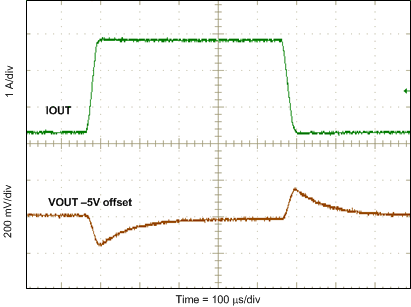 Figure 37. Load Transient
Figure 37. Load Transient
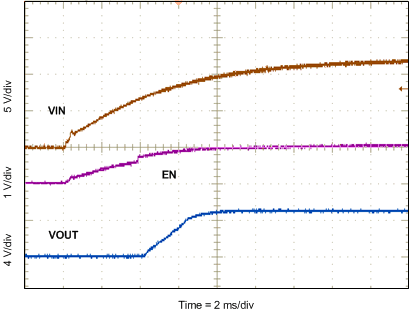 Figure 39. Start-up With VIN
Figure 39. Start-up With VIN
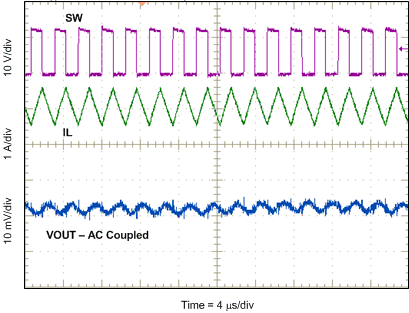 Figure 41. Output Ripple CCM
Figure 41. Output Ripple CCM
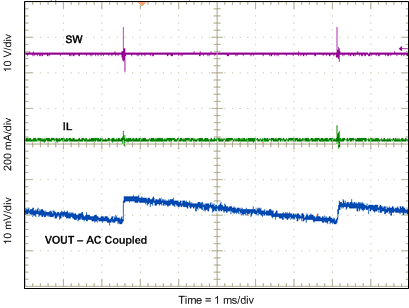 Figure 43. Output Ripple PSM
Figure 43. Output Ripple PSM
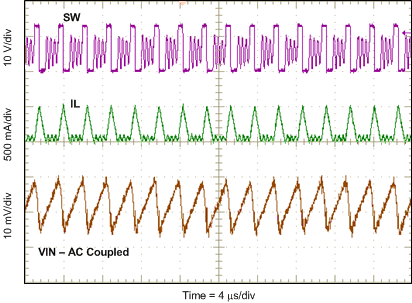 Figure 45. Input Ripple DCM
Figure 45. Input Ripple DCM
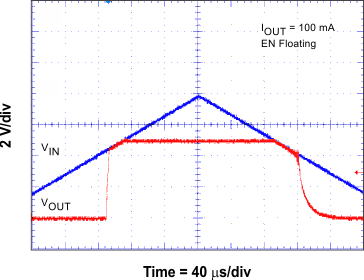 Figure 47. Low Dropout Operation
Figure 47. Low Dropout Operation
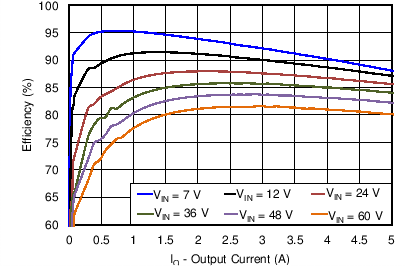 Figure 49. Efficiency vs Load Current
Figure 49. Efficiency vs Load Current
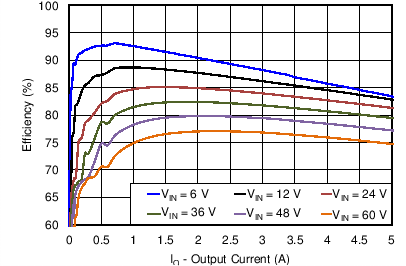 Figure 51. Efficiency vs Load Current
Figure 51. Efficiency vs Load Current
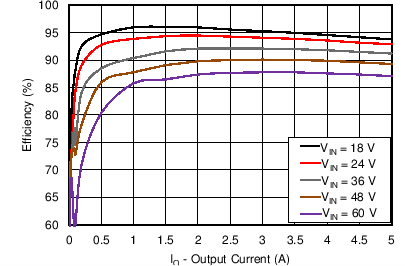 Figure 53. Efficiency vs Output Current
Figure 53. Efficiency vs Output Current
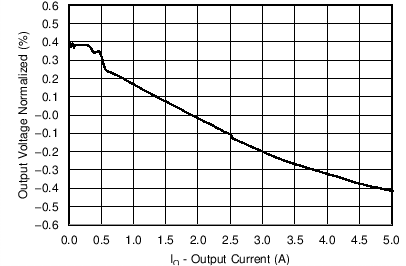 Figure 55. Regulation vs Load Current
Figure 55. Regulation vs Load Current
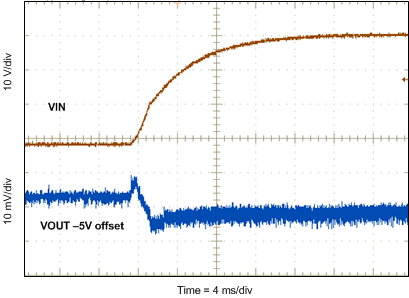 Figure 38. Line Transient (8 V to 40 V)
Figure 38. Line Transient (8 V to 40 V)
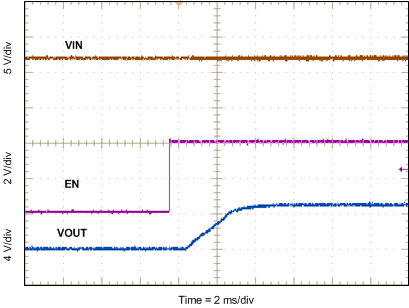 Figure 40. Start-up With EN
Figure 40. Start-up With EN
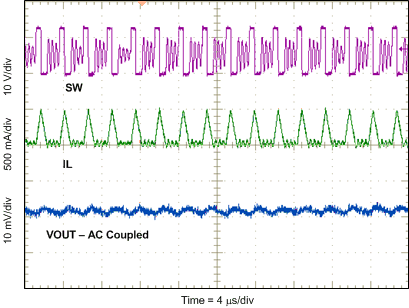 Figure 42. Output Ripple DCM
Figure 42. Output Ripple DCM
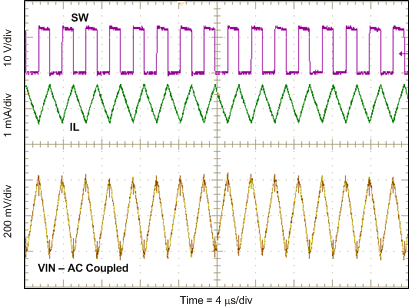 Figure 44. Input Ripple CCM
Figure 44. Input Ripple CCM
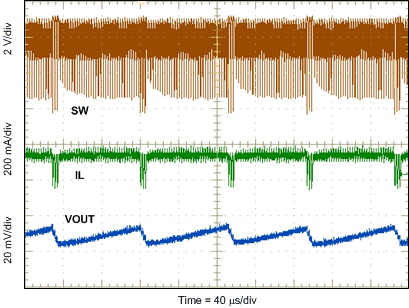 Figure 46. Low Dropout Operation
Figure 46. Low Dropout Operation
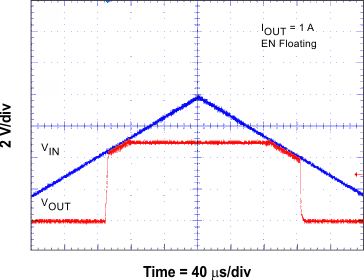 Figure 48. Low Dropout Operation
Figure 48. Low Dropout Operation
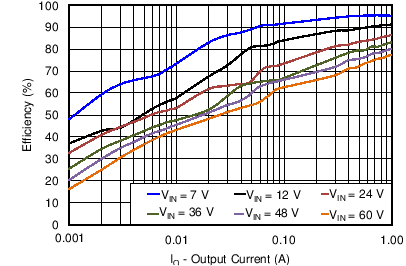 Figure 50. Light Load Efficiency
Figure 50. Light Load Efficiency
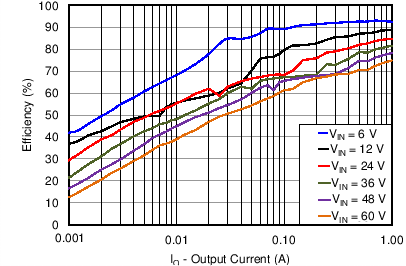 Figure 52. Light Load Efficiency
Figure 52. Light Load Efficiency
 Figure 54. Overall Loop Frequency Response
Figure 54. Overall Loop Frequency Response
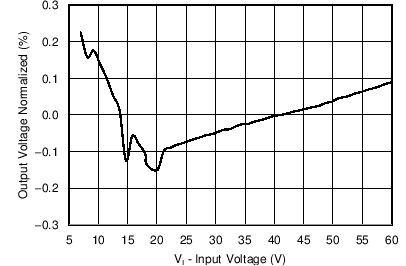 Figure 56. Regulation vs Input Voltage
Figure 56. Regulation vs Input Voltage
9 Power Supply Recommendations
The design of the device is for operation from an input voltage supply range between 4.5 V and 60 V. Good regulation of this input supply is essential. If the input supply is more distant than a few inches from the TPS54560-Q1 converter, the circuit may require additional bulk capacitance besides the ceramic bypass capacitors. An electrolytic capacitor with a value of 100 μF is a typical choice. Furthermore, if the supply voltage in the application is likely to reach negative voltage (for example, reverse battery) a forward diode must be placed at the input of the supply.
